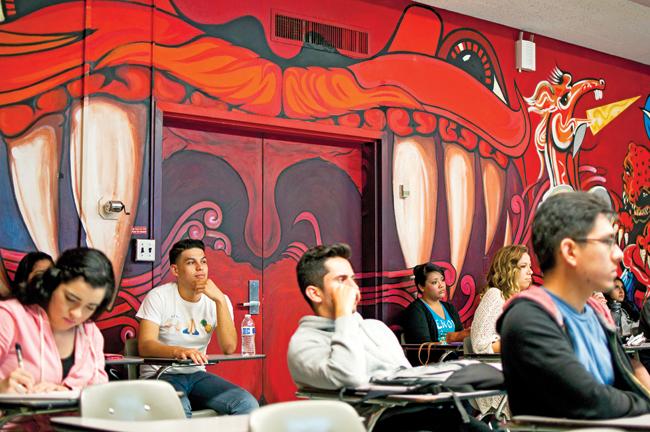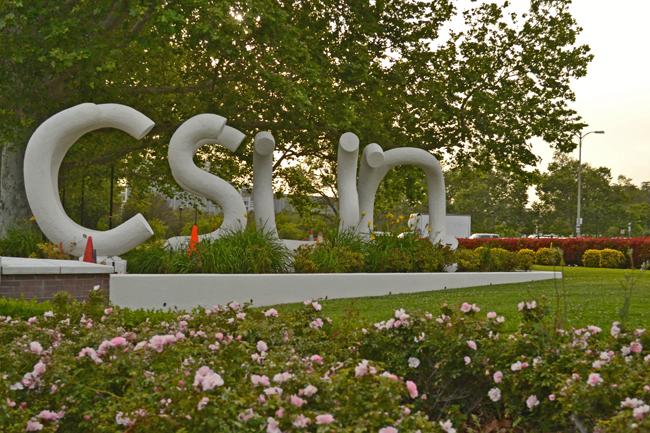
During orientation, volunteers from New Student Orientation (NSO) program on campus walk the grounds with dozens of incoming students, giving them a tour of every building and monument that holds a significance to the school.
At the start of the 2012 spring semester at CSUN, a new monument was added to this tour, creating a sense of belonging to all incoming students.
A statue portraying a man, a matador, that resonates with the more than 36,000 students currently enrolled.
Over the years, however, students may lose sight and interest in these landmarks that represent a vibrant history and presence in everyday campus life.
Thousands of students roam the CSUN campus daily. With their eyes glued to the screen of their smartphones, or being engaged in other activities, it’s easy to miss the campus environment that surrounds them as they walk from one class to the next.
Many students, like Margarita Gutierrez, senior nutrition and dietetics major, went years on campus without noticing or barely recognizing the several different monuments placed around the grounds.
“I didn’t even know we had several monuments,” Gutierrez said. She has been a student at CSUN for six years and the only monument she knows of is the Matador statue.
“It’s right in front of Sequoia Hall, where almost all of my classes are at,” Gutierrez said.
Even though some students aren’t fully aware of the meaning behind the various landmarks, some agree that their importance is vital to campus life. Vanessa Martínez, senior vocal performance major, said the different monuments on campus represent a diverse society, a vibrant one that is dominant throughout campus.
“The different monuments give us a sense of pride and give a unique feel to our campus,” Martínez said.
True for most recent CSUN attendees, the Matador statue represents all current students and alumni. This statue sits between the Oviatt library and the University Student Union (USU), directly across the Matador Square.
Unveiled in 2011 during the freshmen convocation of the fall semester, the Matador statue is a physical representation of the official CSUN mascot, the matador. The slogan, “Students today, Matadors tomorrow,” can be read on the monument.
Funds donated by CSUN students and a fundraising campaign were used to design and create the sculpture.
Like this statue, other monuments are on campus which represent the times and people who have had a significant importance, or who have made a generous contribution to the CSUN community.
In front of the Oviatt library, located on the side of the Donald E. Bianchi Planetarium, stands a concrete monument dedicated to faculty and staff that helped reopen the campus after the 1994 Northridge earthquake that caused a $400 million damage to the campus.
Adjacent to it is a small plaque that commemorates former president Blenda J. Wilson for her efforts in revitalizing the campus after the devastation. The courtyard was dedicated to her at the beginning of the 2014 spring semester.
Sitting at the corner of Nordhoff Street and Zelzah Avenue is another sculpture that resonates with the campus community, the famous CSUN sign. Well-known by students, the sign is praised for its remarkable ability to spell out CSUN when viewed at from any direction, north, south, west or east.
The sign was designed in 1975 by engineering alumni John Banks, and was selected from a campus-wide competition.
Known to have given the Daily Sundial its permanent title, a brick time capsule with a sundial sculpted on top is located in front of the Oviatt Library at the southwest end.
Among these landmarks stand many others. The Orange Grove and Botanical Pond, the Sundial fountain located in front of Bayramian Hall, Cleary Walk, dedicated to former president James Cleary, and the mural representing unrest from the Chicana/o Studies department, located in the Jerome Richfield building.
For Abraham Martinez, who has a bachelor’s degree in sociology, , walking by these landmarks everyday gave him a sense of belonging. He says that these artworks encompass the struggles that several people went through and possibly still go through today, such as the earthquake monument and the mural in Jerome Richfield.
“These are important because they add to the culture of college life,” said alumnus Abraham Martinez, who has a bachelor’s degree in sociology.
